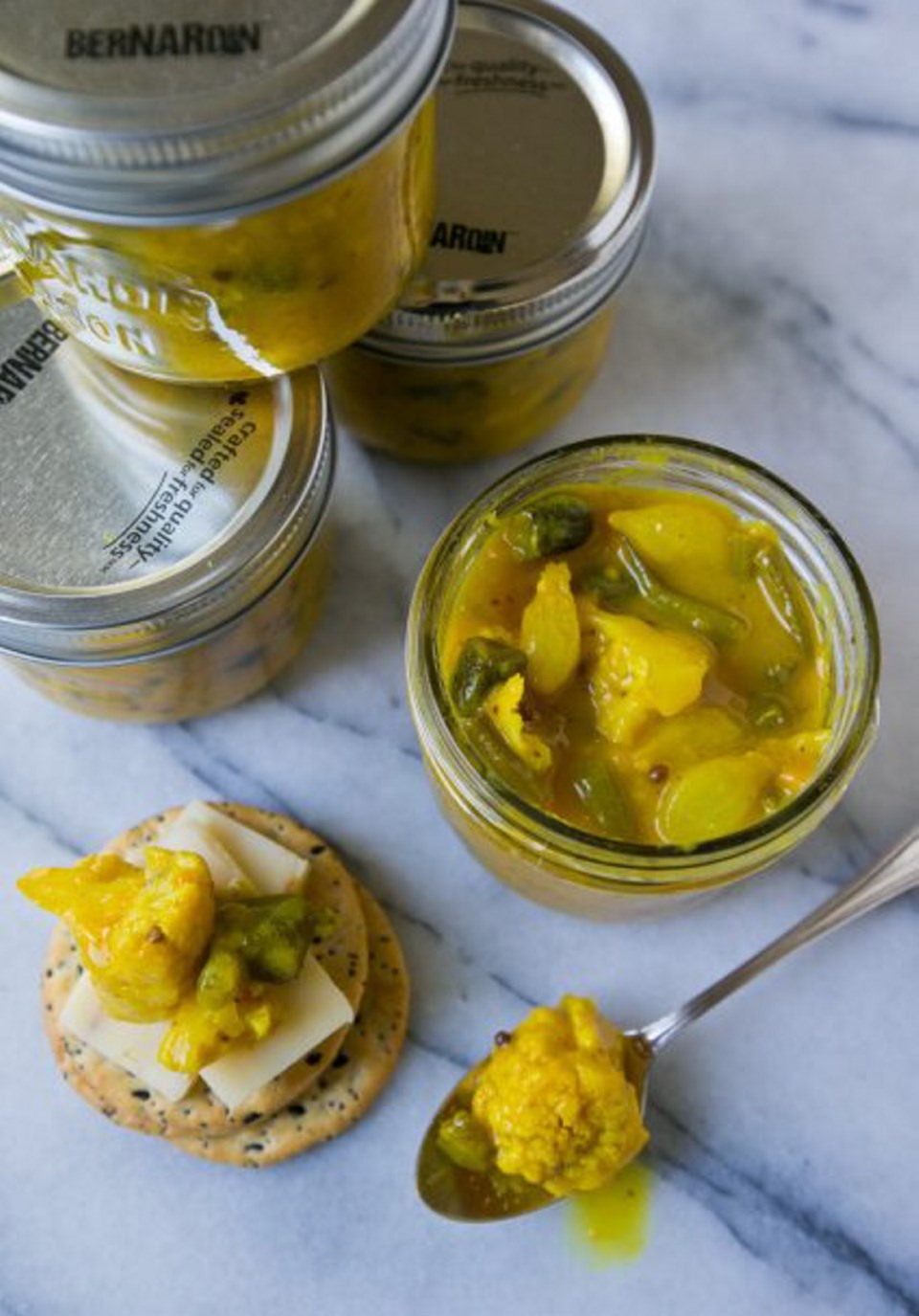 Dear Eric: I have a good friend who really enjoys the Heinz (U.K. brand) piccalilli, which is crunchy and tangy, she tells me. Other brands do not measure up, she says.
Dear Eric: I have a good friend who really enjoys the Heinz (U.K. brand) piccalilli, which is crunchy and tangy, she tells me. Other brands do not measure up, she says.
It is often not available in stores here in Victoria, but every so often, I have found it. I see there are some “vegetables” included, but not sure what they are.
I wonder if you have a recipe that measures up so I could make it for her. She’s nearing 80 and has a hand disability, so cooking is difficult for her, and this would be fun for me to try.
Gail
For those of you who have not tried piccalilli, it’s a mustardy relish/pickle popular in the United Kingdom and in places where folks from that part of the world immigrated to, such as Canada. It’s also popular with people from any part of the world who enjoy mustard-flavoured pickles with bit of a kick, such as me.
According to the website British History Online (british-history.ac.uk), in the past, piccalilli was also known as Indian pickle, an indication of whose cuisine inspired this condiment.
According to the Foods of England Project (foodsofengland.co.uk), the exact origin of piccalilli is unknown, but appears to be from the 18th century and could be related to a number of similar Indian pickles enjoyed in the United Kingdom at that time.
The Oxford English Dictionary suggests the word “piccalilli” began to form in 1758. That’s when Hannah Glasse, an English cookery writer, described how to make paco-lila, or India pickle, in one of her cookery books. She deemed it a ginger-flavoured, Indian-style pickle “rolling sauce,” which is expected to be constantly topped-up as different vegetables come into season.
These days, piccalilli is still made with vegetables, cauliflower being the most notable. You’ll find ginger still added to recipes, but the dominant flavour comes from pungent mustard. Another key ingredient is turmeric, which gives piccalilli its vibrant yellow colour.
Depending on the maker, other vegetables are also used to make piccalilli, such as vegetable marrow (summer squash), cucumber, beans and onions, as are other spices, such as cardamom and clove.
Gail said her friend likes Heinz brand piccalilli and when I read its ingredients online, I saw that it contained cauliflower, onions, gherkins (tiny pickles), spirit vinegar, sugar, mustard, cornflour, mustard, salt, spices and flavourings, such as celery. The Heinz product also contained sulphites, a preservative; calcium chloride, a firming agent; and plain caramel, for colouring.
When I came up with my piccalilli recipe, to please Gail’s friend, it seemed logical to use the type of ingredients found in the Heinz product. I didn’t, of course, use sulphites, calcium chloride or colouring, so my piccalilli does not have quite the same texture and look. But it has an appealing tanginess and rich flavour and yielded seven jars, providing some to enjoy now and some to enjoy weeks from now.
Eric’s Piccalilli
Serve this tangy mustard pickle with sharp cheeses, roasts, meat pies, ham, sausages and any other food you think it would complement.
Preparation time: 75 to 90 minutes
Cooking time: About 60 minutes
Makes: Seven (250 ml) jars
1⁄4 lb. thin, fresh green beans, trimmed and cut, widthwise, into 1⁄2-inch slices
1 (375 mL) jar gherkins (see Note 1)
3 cups malt vinegar
1 cup granulated sugar
2 Tbsp coriander seeds
1 tsp celery seeds
4 tsp pickling salt
5 cups small cauliflower florets (each about an inch long; see Note 2)
1 (300 gram) bag frozen pearl onions
3 Tbsp English-style mustard powder
(I used Keen’s brand; see Eric’s options)
3 Tbsp all-purpose flour
11⁄2 tsp ground turmeric
1 tsp ground ginger
1⁄4 tsp garlic powder
1⁄4 cup malt vinegar
7 (250 mL) canning jars
Bring a small pot of water to a rapid boil. Add the sliced green beans and cook one minute. Drain the beans well, and then cool in ice-cold water. Drain the beans well again, transfer to a bowl and refrigerate until needed.
Drain the gherkins well, set on a cutting board and cut, widthwise, into 1⁄2-inch pieces. Transfer to a bowl and refrigerate gherkins until needed.
Fill a boiling water canner or large pot with water and bring to a boil.
Meanwhile, put the three cups malt vinegar, sugar, coriander seeds, celery seeds and salt in a medium to large non-reactive (non-aluminum) pot (mine was eight inches wide and five inches tall). Bring to a boil, stirring to dissolve the sugar. Add the cauliflower and onions; bring to a simmer, adjusting the heat as needed to maintain that simmer. Simmer the cauliflower for four minutes, or until the florets have softened, but still retain a bit of crunchiness.
Set a large sieve over a bowl. Drain the cauliflower and onions into the sieve. Put the liquid back into the pot and set aside for now. Place the drained cauliflower and onion into the bowl and set aside.
Combine the mustard, flour, turmeric, ginger and garlic powder in a small bowl. Whisk in the 1⁄4 cup malt vinegar until smooth. Ladle 1⁄2 cup of the hot vinegar/ sugar mixture into the mustard mixture and whisk until well combined. Now whisk the spice/mustard mixture into the pot with the remaining hot vinegar/sugar mixture.
Bring the mixture in the pot to a simmer, and whisk and simmer until it lightly thickens, about three to five minutes.
Remove the pot from the heat, and then mix in the cauliflower, onions, green beans and gherkins.
Sterilize the canning jars in the boiling water for 10 minutes. Remove the jars and boil their snap-top lids for five minutes.
Spoon the piccalilli mixture into the hot, sterilized jars, leaving 1⁄2-inch headspace.
Wipe rims clean, top with sterilized snap-top lids, and then apply screw band until fingertip-tight.
Process sealed jars in boiling water for 15 minutes. Remove from the water, set on a cooling rack and cool at room temperature 24 hours. Check seal. A properly sealed lid curves downward. Label, date and store the piccalilli in a cool, dark place.
Note 1: Use sour-tasting gherkins for the piccalilli, not the sweet type. The brand I used was Maille Crunchy Mild Gherkins. It is sold in the pickle aisle of many supermarkets.
Note 2: One, 11⁄2-pound cauliflower should yield the five cups of florets needed for this recipe. Remove the outer leaves and core before cutting it into small florets.
Eric’s options: For spicier piccalilli, add 1 Tbsp more of the mustard powder. For thicker piccalilli, increase flour by 1 Tbsp.
Eric Akis is the author of The Great Rotisserie Chicken Cookbook (Appetite by Random House). His columns appear in the Life section Wednesday and Sunday.



